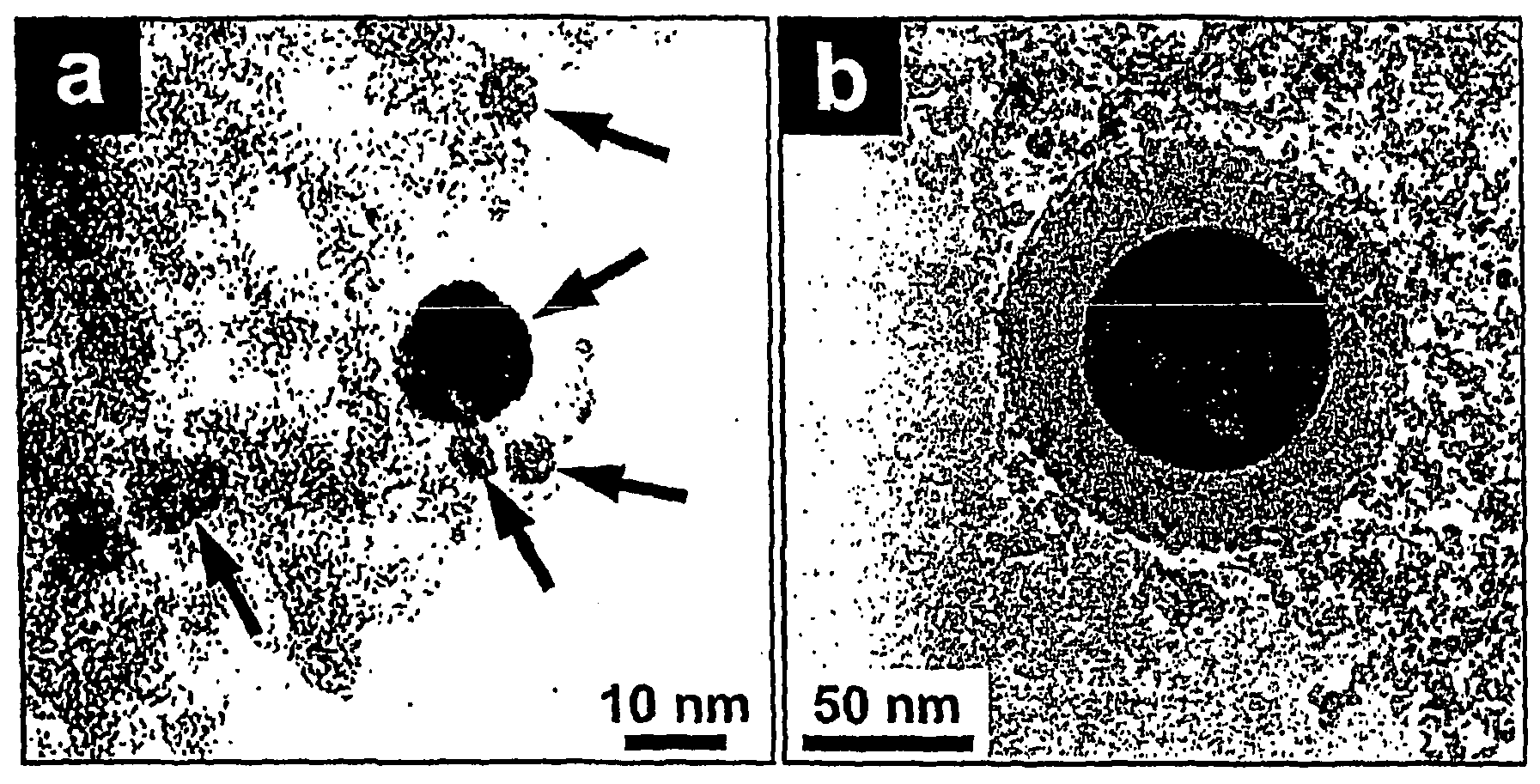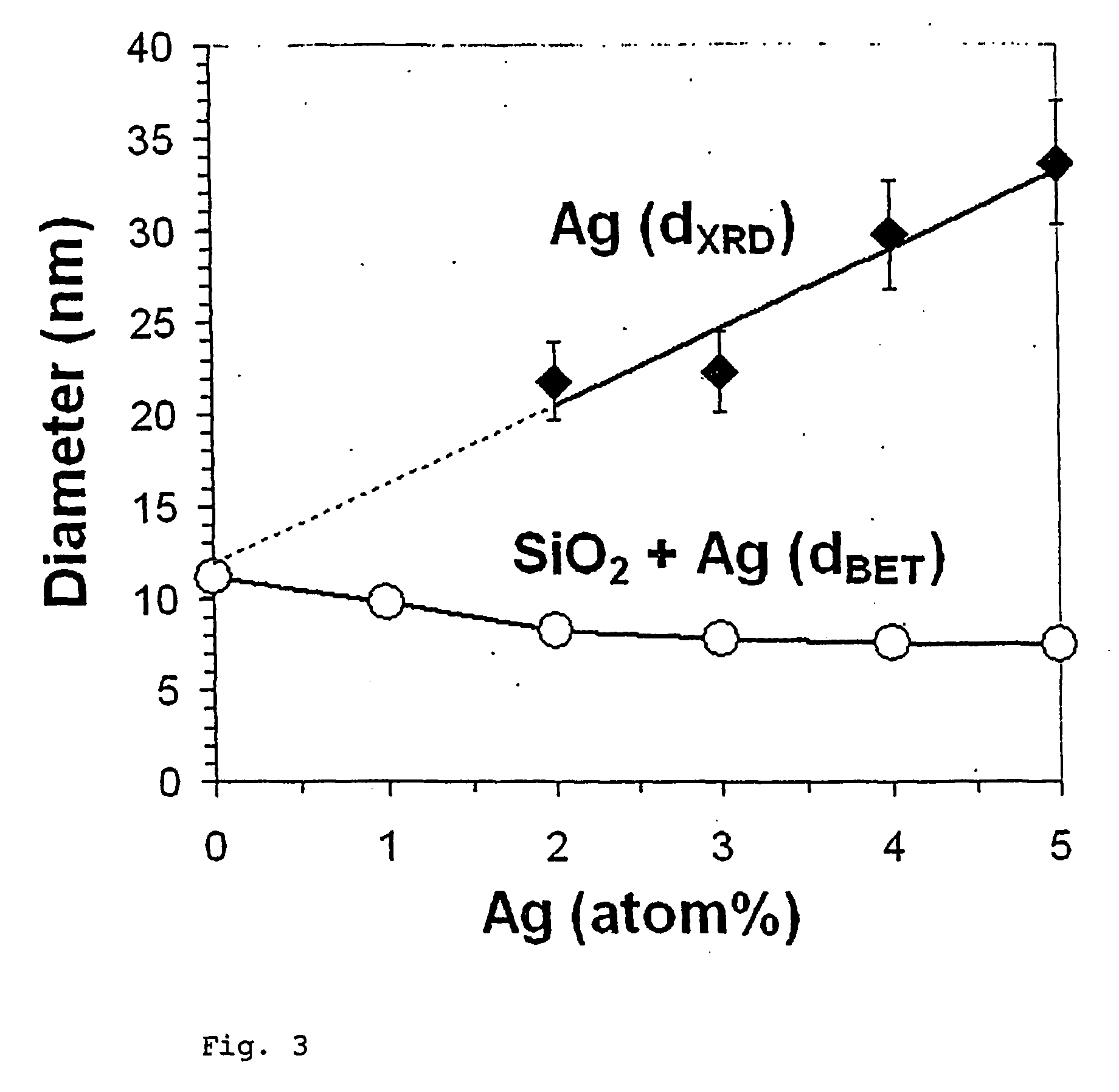Antimicrobial and Antifungal Powders Made by Flame Spray Pyrolysis
- Summary
- Abstract
- Description
- Claims
- Application Information
AI Technical Summary
Benefits of technology
Problems solved by technology
Method used
Image
Examples
example 1
Production of Silver Doped Silica Particles
[0066]Silver doped silica particles were produced by flame spray pyrolysis using a flame spray pyrolysis (FSP) nozzle[7] that had a radially symmetric configuration with a stainless-steel capillary tube (ID 0.41 mm; OD 0.71 mm) at the central axis serving as the liquid feed nozzle (see FIG. 1). Immediately surrounding the capillary tube was a narrow annular gap of adjustable cross-sectional area, that issued 5 L / min of oxygen for spray atomization of the liquid feed. The pressure drop across the nozzle was maintained at 1.5 bar during FSP operation. A narrow concentric orifice ring (0.15 mm spacing, 6 mm radius from nozzle axis) was supplied with a mixture of CH4 (1.5 L / min) and O2 (3.2 L / min) to serve as a premixed pilot flame for ignition and support of the spray flame. A sheath gas flow of 5 L / min of oxygen was issued through an annular sintered metal frit (8 mm width, inner radius 9 mm from the nozzle axis) to stabilize and contain the ...
example 2
[0074]The powder X-ray diffraction (XRD) was performed with a Bruker AXS D8 Advance spectrometer at 2θ (Cu—Kα) 10 to 70°, a step size of 0.03°, and a scan speed of 0.6° / min (source 40 kV, 40 mA). XRD patterns were analyzed using the Fundamental Parameter (FP) method to match the profile of individual peaks within each XRD pattern, allowing extraction of crystallite size information[8]. The XRD patterns for Ag-doped silica for silver concentrations between 0 and 5 at. % are shown in FIG. 2. The presence of amorphous silica (a-SiO2) in the sample is clearly reflected in the broad peak appearing in the baseline between 15 and 35°. Peaks corresponding to metallic silver are indicated with asterixes at 38.1, 44.3 and 64.5°. These peaks correspond to the (111), (200) and (220) silver crystal planes respectively. The indicated peaks are consistent with reference pattern PDF 87-0717[9] and no peaks were observed for silver oxides.
[0075]The silver XRD peaks, and most ...
example 3
Particle Size Determination
[0076]BET adsorption isotherms and specific surface area analysis were performed using a MicroMeritics TriStar 3000 system after degassing in nitrogen for 1.5 hours at 150° C. The specific surface area (SSA) was measured using 5-point nitrogen adsorption at 77 K. The BET equivalent diameter was evaluated from the measured SSA for each sample, assuming a spherical primary particle geometry and a composition-corrected density. The such obtained BET equivalent diameter (dBET) was compared with the diameters estimated from the XRD patterns using the fundamental parameter approach.
[0077]The results obtained with said two methods of particle size analysis as a function of silver concentration are shown in FIG. 3. The open circles show the BET equivalent diameter (dBET) of the as-produced powder where the diameter was evaluated based on the measured specific surface area of the silver-doped silica powder. This BET equivalent diameter was observed to decrease from...
PUM
| Property | Measurement | Unit |
|---|---|---|
| Antimicrobial properties | aaaaa | aaaaa |
| Selectivity | aaaaa | aaaaa |
| Morphology | aaaaa | aaaaa |
Abstract
Description
Claims
Application Information
 Login to View More
Login to View More - R&D
- Intellectual Property
- Life Sciences
- Materials
- Tech Scout
- Unparalleled Data Quality
- Higher Quality Content
- 60% Fewer Hallucinations
Browse by: Latest US Patents, China's latest patents, Technical Efficacy Thesaurus, Application Domain, Technology Topic, Popular Technical Reports.
© 2025 PatSnap. All rights reserved.Legal|Privacy policy|Modern Slavery Act Transparency Statement|Sitemap|About US| Contact US: help@patsnap.com



